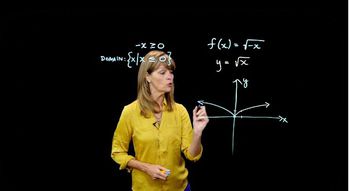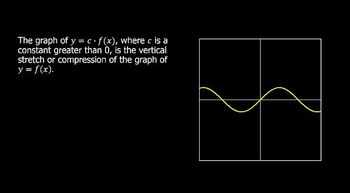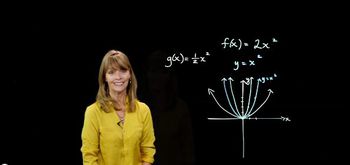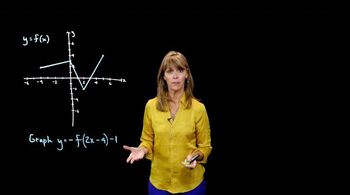Table of contents
- 0. Review of Algebra4h 16m
- 1. Equations & Inequalities3h 18m
- 2. Graphs of Equations43m
- 3. Functions2h 17m
- 4. Polynomial Functions1h 44m
- 5. Rational Functions1h 23m
- 6. Exponential & Logarithmic Functions2h 28m
- 7. Systems of Equations & Matrices4h 6m
- 8. Conic Sections2h 23m
- 9. Sequences, Series, & Induction1h 19m
- 10. Combinatorics & Probability1h 45m
3. Functions
Transformations
Problem 75b
Textbook Question
Graph each function. See Examples 6–8 and the Summary of Graphing Techniques box following Example 9. h(x)=-(x+1)^3
 Verified step by step guidance
Verified step by step guidance1
Identify the basic function: The function given is a transformation of the basic cubic function \( f(x) = x^3 \).
Determine the transformations: The function \( h(x) = -(x+1)^3 \) involves a horizontal shift, a reflection, and a vertical stretch/compression.
Horizontal shift: The term \((x+1)\) indicates a shift to the left by 1 unit.
Reflection: The negative sign in front of \((x+1)^3\) indicates a reflection across the x-axis.
Graph the function: Start with the basic graph of \( f(x) = x^3 \), apply the left shift, and then reflect it across the x-axis.
Recommended similar problem, with video answer:
 Verified Solution
Verified SolutionThis video solution was recommended by our tutors as helpful for the problem above
Video duration:
1mPlay a video:
Was this helpful?
Key Concepts
Here are the essential concepts you must grasp in order to answer the question correctly.
Function Graphing
Graphing a function involves plotting points on a coordinate plane that represent the output values of the function for given input values. Understanding how to interpret the function's equation and its transformations is crucial for accurately representing its behavior visually.
Recommended video:

Graphs of Logarithmic Functions
Transformations of Functions
Transformations refer to changes made to the graph of a function, including shifts, reflections, stretches, and compressions. In the function h(x)=-(x+1)^3, the negative sign indicates a reflection over the x-axis, while the (x+1) indicates a horizontal shift to the left by one unit.
Recommended video:

Domain & Range of Transformed Functions
Cubic Functions
Cubic functions are polynomial functions of degree three, characterized by their general form f(x) = ax^3 + bx^2 + cx + d. They typically exhibit an 'S' shaped curve and can have one or two turning points, which are important for understanding their overall shape and behavior when graphed.
Recommended video:

Function Composition

 5:25m
5:25mWatch next
Master Intro to Transformations with a bite sized video explanation from Nick Kaneko
Start learningRelated Videos
Related Practice

























